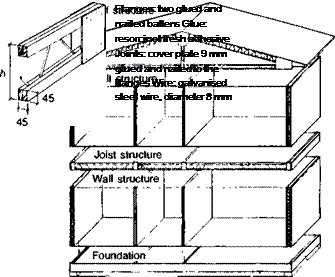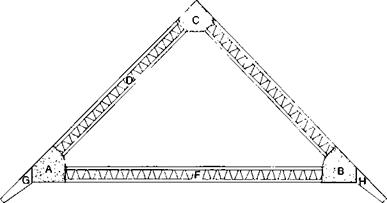 |
There exist a number of very diverse uses for adhesives in both new work and in existing structures. Nevertheless, in such cases the adhesive would generally be called upon to act in a structural manner.
Fig. 8.18. Wirewood.
A similar concept to glulam and concrete segmental construction can involve the fabrication by bonding, usually with epoxides, of awkward or special shapes and units made of concrete or clay brick. Examples include ‘special’ roof tiles and building blocks formed by cutting and bonding standard production shapes to provide new forms.
Wirewood describes a Swedish structural innovation in beams and stud partitioning, and consists of timber flanges connected by steel bars which are mechanically restrained and bonded into position (Fig. 8.18). The assemblies can be formed into various sizes and depths, and be used as floor joists, in wall frames, or in roof trusses (Fig. 8.19). A simple cost-effective modular approach to building is claimed by European Building Components who market the system. Another use of adhesives in bonding steel to wood has involved the incorporation of flitch plates for making hidden connections between glulam members(29). The adjacent members of a portal frame sports centre structure in Dundee were slotted, in section, to accommodate a steel plate which was both epoxy-bonded and bolted through the timber. Load testing indicated that the configuration behaved as a composite section over the length of the connection. Widespread use is also made of bonding steel bolts into glulam structures in Scandinavia, further demonstrating the confidence in such steel/wood bonded connections.
Resin anchors are quite widely used already for fixing steel bars and ties in concrete and masonry structures. A concept marketed
|
Fig. 8.19. Truss assembled from Wirewood. 295 |
more recently by Pitchmastic(30) enables the retro-fixing of wall ties, structural support dowels and inclined panel ties into cavity walls or poor quality masonry (see also Fig. 6.26). A polyester resin is injected into the annulus formed by drilling out the substrates, and a polypropylene sleeve is used to bridge the cavity, if required. The remedial wall tie market is growing steadily, and versatile resinous solutions will be required increasingly.
 28 сентября, 2015
28 сентября, 2015  Malyar
Malyar 
 Опубликовано в рубрике
Опубликовано в рубрике 